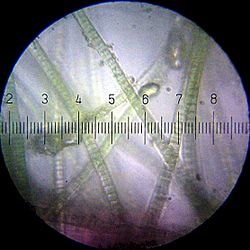Menu
-

Home
Homepage
KidzSearch
-

Games
Play Fun Mobile Games.
Games
-

KidzTube
Cool Videos for Kids.
Videos
-

KidzTalk
Talk About Anything
Q&A
-

KidzNet
Social Network for Kids
KidzNet
-

Pictures
Explore Popular Images.
Pics
-

Top Sites
Explore the Best Sites for Kids.
Websites
-

Music
Listen to Streaming Music for Kids.
Radio
-

Cool Facts
Facts for Kids.
Facts
-

Kids News
Read About Cool Topics.
News
-

Encyclopedia
Browse Over 200,000 Student Articles.
Wiki
-

Boolify
Learn How to Search with Boolify.
Boolify
-

Mobile Apps
Discover KidzSearch Apps
Apps



Cyanobacteria are a taxon of bacteria which conduct photosynthesis. They are not algae, though they were once called blue-green algae. It is a phylum of bacteria, with about 1500 species. In endosymbiont theory, chloroplasts (plastids) are descended from cyanobacteria. Their DNA profile is evidence for this.
Cyanobacteria have an extremely long fossil record, starting at least 3,500 million years ago. They were the main organisms in the stromatolites of the Archaean and Proterozoic eons.
The ability of cyanobacteria to perform oxygenic photosynthesis is highly significant. The early atmosphere on Earth was largely reducing, that is, without oxygen. The cyanobacteria in stromatolites were the first known organisms to photosynthesise and produce free oxygen. After about a billion years, the effect of this photosynthesis began a huge change in the atmosphere. The process, called the Great Oxygenation Event, took a long time. Eventually, it killed off most of the organisms which could not live in oxygen, and led to the kinds of environment we know today, where most organisms use and need oxygen.
view more...- Related to cyanobacteria
- cyanobacteria release
- cyanobacteria atmosphere
- cyanobacteria process
- cyanobacteria fossil
- watch cyanobacteria videos on kidztube
- play cyanobacteria games
Post It On KidzTalk Homework Help
Report a search problem
home contact us settings advertise terms/privacyabout usteacher forum
View All
- COMPANY
- contact us
- settings
- advertise
- terms/privacy
- about us
- RESOURCES
- api services
- link to us
- add a site
- media/press
- education daily journal
- blocking websites
- teacher forum
- affiliate program
- make us your default search
- search help
- kidzsearch apps
- voice search
- LINKS
- home
- kidznet
- kidznet directory
- kidztalk
- kidztube
- games
- images
- top sites
- music
- facts
- news
- wiki
- boolify
- SOCIAL
desktop version
Powered by Google SafeSearch
Copyright 2005-2024 KidzSearch.com

